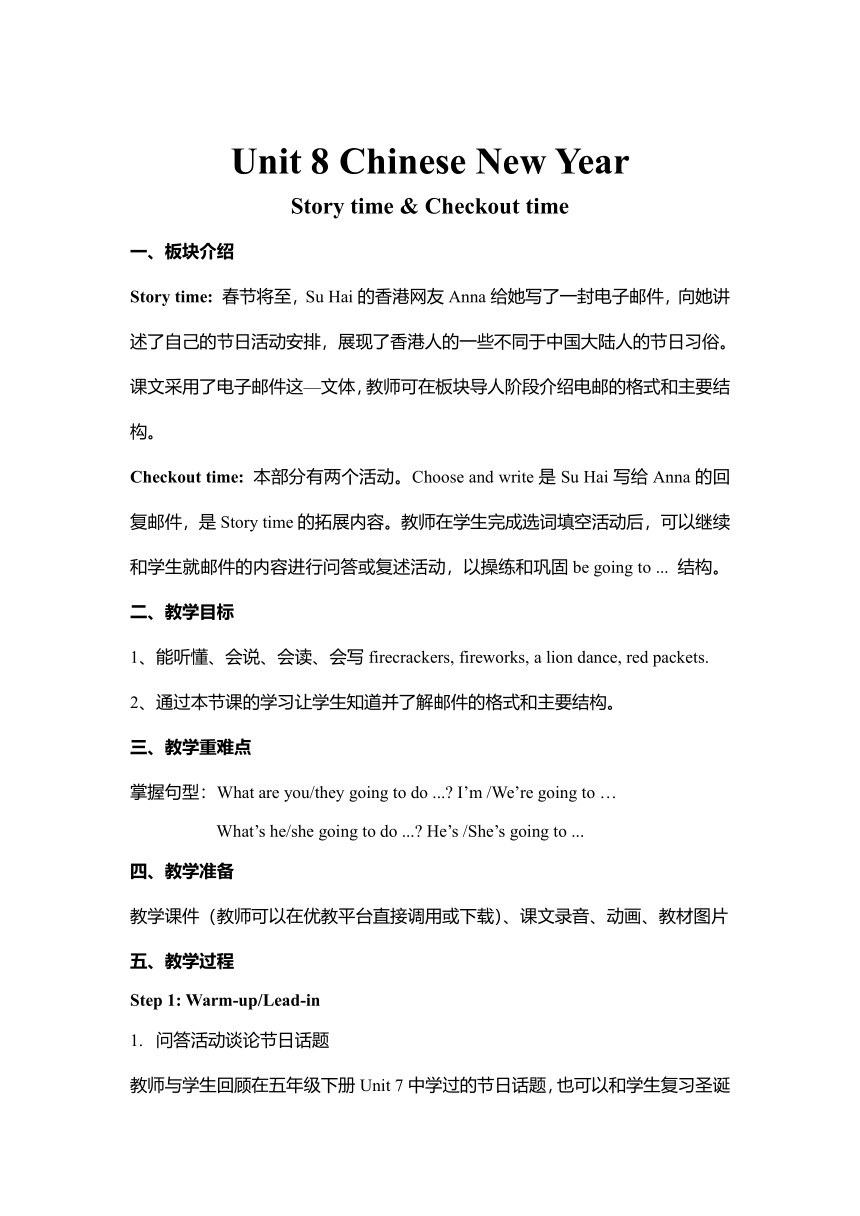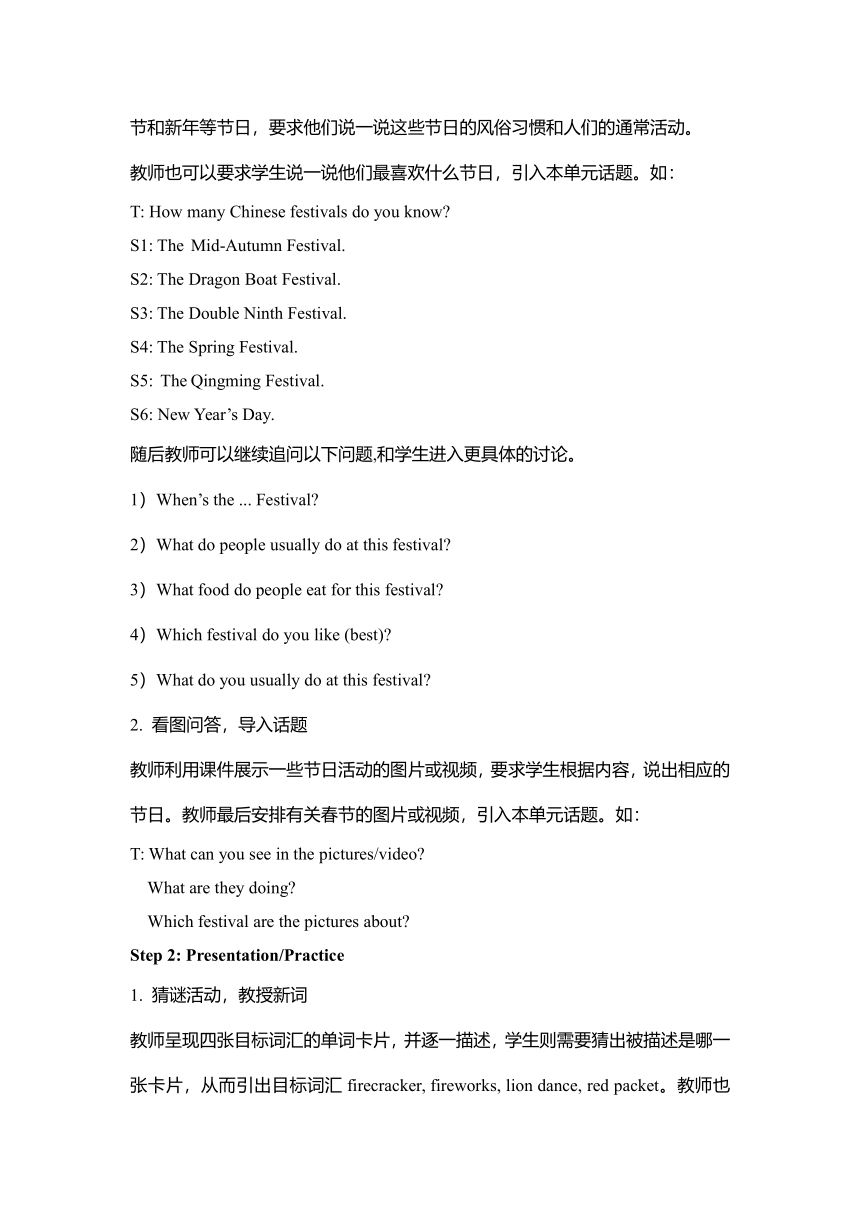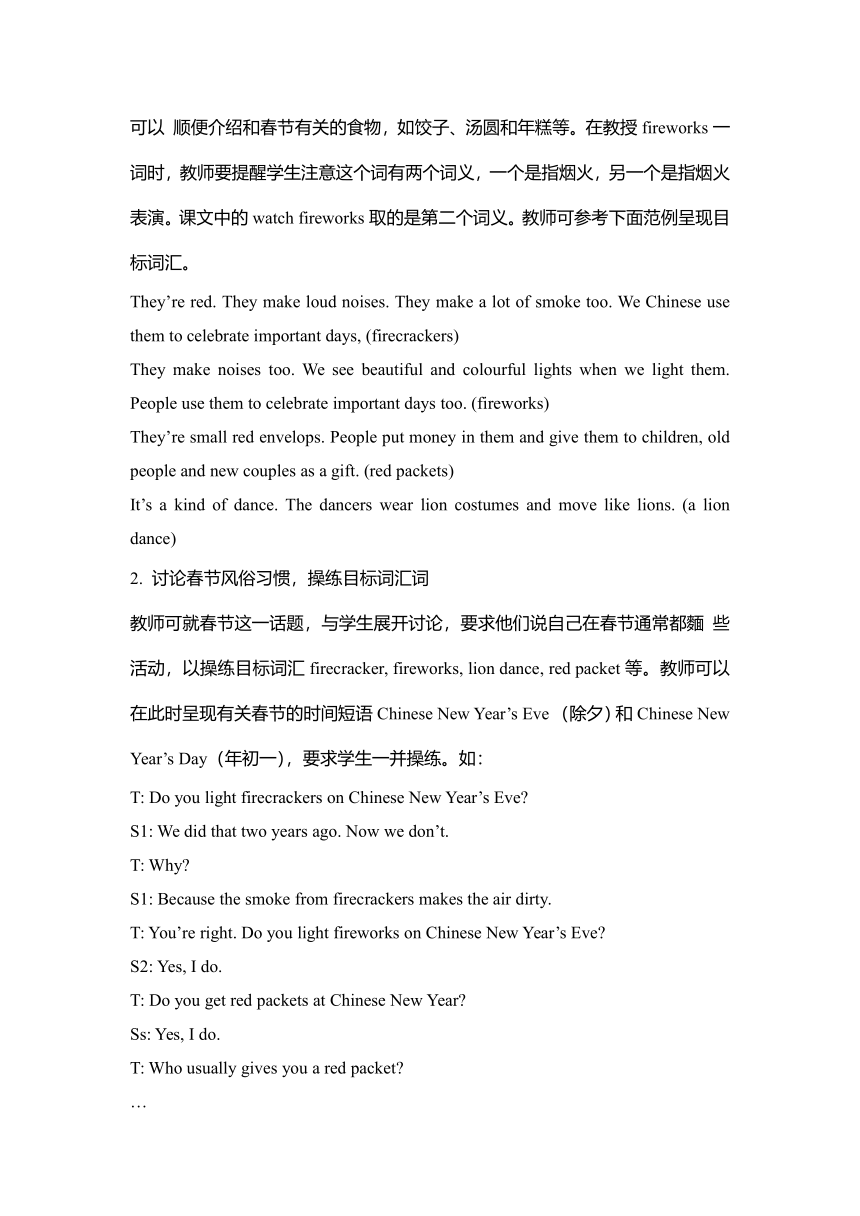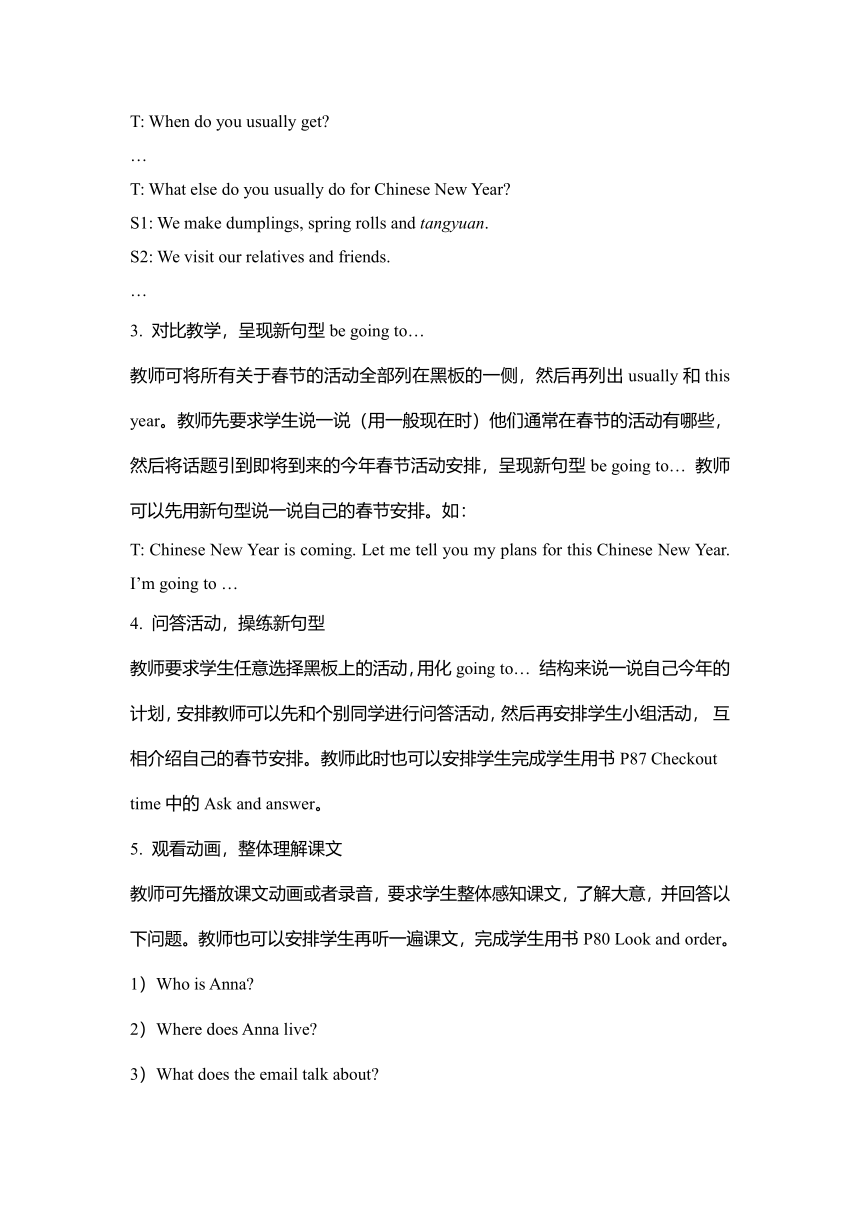Unit 8 Chinese New Year-Story time & Checkout time 教案
文档属性
| 名称 | Unit 8 Chinese New Year-Story time & Checkout time 教案 |  | |
| 格式 | docx | ||
| 文件大小 | 25.1KB | ||
| 资源类型 | 教案 | ||
| 版本资源 | 牛津译林版 | ||
| 科目 | 英语 | ||
| 更新时间 | 2021-07-30 17:04:26 | ||
图片预览




文档简介
Unit 8 Chinese New Year
Story time & Checkout time
一、板块介绍
Story time: 春节将至,Su Hai的香港网友Anna给她写了一封电子邮件,向她讲述了自己的节日活动安排,展现了香港人的一些不同于中国大陆人的节日习俗。课文采用了电子邮件这—文体,教师可在板块导人阶段介绍电邮的格式和主要结构。
Checkout time: 本部分有两个活动。Choose and write是Su Hai写给Anna的回复邮件,是Story time的拓展内容。教师在学生完成选词填空活动后,可以继续和学生就邮件的内容进行问答或复述活动,以操练和巩固be going to ... 结构。二、教学目标
1、能听懂、会说、会读、会写firecrackers, fireworks, a lion dance, red packets.
2、通过本节课的学习让学生知道并了解邮件的格式和主要结构。
三、教学重难点
掌握句型:What are you/they going to do ...? I’m /We’re going to …
What’s he/she going to do ...? He’s /She’s going to ...
四、教学准备
教学课件(教师可以在优教平台直接调用或下载)、课文录音、动画、教材图片
五、教学过程
Step 1: Warm-up/Lead-in
问答活动谈论节日话题
教师与学生回顾在五年级下册Unit 7中学过的节日话题,也可以和学生复习圣诞节和新年等节日,要求他们说一说这些节日的风俗习惯和人们的通常活动。
教师也可以要求学生说一说他们最喜欢什么节日,引入本单元话题。如:
T: How many Chinese festivals do you know?
S1: The Mid-Autumn Festival.
S2: The Dragon Boat Festival.
S3: The Double Ninth Festival.
S4: The Spring Festival.
S5: The Qingming Festival.
S6: New Year’s Day.
随后教师可以继续追问以下问题,和学生进入更具体的讨论。
1)When’s the ... Festival?
2)What do people usually do at this festival?
3)What food do people eat for this festival?
4)Which festival do you like (best)?
5)What do you usually do at this festival?
2. 看图问答,导入话题
教师利用课件展示一些节日活动的图片或视频,要求学生根据内容,说出相应的节日。教师最后安排有关春节的图片或视频,引入本单元话题。如:
T: What can you see in the pictures/video?
What are they doing?
Which festival are the pictures about?
Step 2: Presentation/Practice
1. 猜谜活动,教授新词
教师呈现四张目标词汇的单词卡片,并逐一描述,学生则需要猜出被描述是哪一张卡片,从而引出目标词汇firecracker, fireworks, lion dance, red packet。教师也可以 顺便介绍和春节有关的食物,如饺子、汤圆和年糕等。在教授fireworks一词时,教师要提醒学生注意这个词有两个词义,一个是指烟火,另一个是指烟火表演。课文中的watch fireworks取的是第二个词义。教师可参考下面范例呈现目标词汇。
They’re red. They make loud noises. They make a lot of smoke too. We Chinese use them to celebrate important days, (firecrackers)
They make noises too. We see beautiful and colourful lights when we light them. People use them to celebrate important days too. (fireworks)
They’re small red envelops. People put money in them and give them to children, old people and new couples as a gift. (red packets)
It’s a kind of dance. The dancers wear lion costumes and move like lions. (a lion dance)
2. 讨论春节风俗习惯,操练目标词汇词
教师可就春节这一话题,与学生展开讨论,要求他们说自己在春节通常都麵 些活动,以操练目标词汇firecracker, fireworks, lion dance, red packet等。教师可以 在此时呈现有关春节的时间短语Chinese New Year’s Eve (除夕)和Chinese New Year’s Day(年初一),要求学生一并操练。如:
T: Do you light firecrackers on Chinese New Year’s Eve?
S1: We did that two years ago. Now we don’t.
T: Why?
S1: Because the smoke from firecrackers makes the air dirty.
T: You’re right. Do you light fireworks on Chinese New Year’s Eve?
S2: Yes, I do.
T: Do you get red packets at Chinese New Year?
Ss: Yes, I do.
T: Who usually gives you a red packet?
…
T: When do you usually get?
…
T: What else do you usually do for Chinese New Year?
S1: We make dumplings, spring rolls and tangyuan.
S2: We visit our relatives and friends.
…
3. 对比教学,呈现新句型be going to…
教师可将所有关于春节的活动全部列在黑板的一侧,然后再列出usually和this year。教师先要求学生说一说(用一般现在时)他们通常在春节的活动有哪些,然后将话题引到即将到来的今年春节活动安排,呈现新句型be going to… 教师可以先用新句型说一说自己的春节安排。如:
T: Chinese New Year is coming. Let me tell you my plans for this Chinese New Year. I’m going to …
4. 问答活动,操练新句型
教师要求学生任意选择黑板上的活动,用化going to… 结构来说一说自己今年的 计划,安排教师可以先和个别同学进行问答活动,然后再安排学生小组活动, 互相介绍自己的春节安排。教师此时也可以安排学生完成学生用书P87 Checkout
time中的Ask and answer。
5. 观看动画,整体理解课文
教师可先播放课文动画或者录音,要求学生整体感知课文,了解大意,并回答以下问题。教师也可以安排学生再听一遍课文,完成学生用书P80 Look and order。1)Who is Anna?
2)Where does Anna live?
3)What does the email talk about?
4)Does Anna like Chinese New Year?
6. 自读课文,获取关键信息
教师安排学生独立阅读课文,并完成下面的表格信息,或完成学生用书P80 Think and write。
Who
are going to
What
When
Anna and her family
buy new clothes and
food, make cakes and tangyuan
tomorrow
Anna and her family
have dinner,
buy some flowers
on Chinese New Year’s Eve
Anna’s parents
give Anna red packets, watch a lion dance
on Chinese New Year’s Day
They
watch fireworks
on 2nd day of
Chinese New Year
7. 根据表格信息,问答活动
教师可以根据表格信息,和学生进行问答活动,操练be going to ... 结构的第三人称形式。如:
T: What’s Anna going to do tomorrow?
Ss: She’s going to ...
T: What food are they going to make tomorrow evening?
Ss: They’re going to...
8. 小组活动,复述课文
教师可以安排学生四人一组,根据表格或者图片信息,以接龙的形式复述课文。 如:
S1: It’s going to be Chinese New Year next week.
S2: Anna is very excited.
S3: Anna and her family are going to buy some new clothes and food tomorrow.
S4: They’re going to make some cakes and tangyuan tomorrow evening.
Step 3: Consolidation
1. 卡片游戏,操练新句型,巩固课文内容
教师安排学生分组活动,在课文中找出关于Anna春节活动的词组,写在卡片上。然后学生在小组内相互抽取卡片,用be going to… 结构说出完整的句子。教师可先将要操练的句型和时间短语呈现在黑板上,供学生选用,如is going to…, are going to…, tomorrow, on Chinese New Year’s Eve/Day, on 2nd day of Chinese New Year。
2. 两人回答活动
教师可组织学生两人一组,就课文内鍵行问答,操练be going to… 结构。教师可
利用多媒体课件呈现本单元主要句型,引导学生根据课文内容向他人进行提问。 如:
S1: What’s Anna going to do tomorrow/on Chinese New Year Eve/on Chinese New Year’s Day/on the second day of Chinese New Year?
S2: She’s going to...
3. 看图说话
教师可以事先让学生收集一些自己往年春节所拍摄的照片,然后呈现给所有学生,要求他们分别用一般现在时、一般过去时和be going to ... 结构描述。
4. 拓展活动
教师在学生充分理解了课文之后,可以安排学生写一封回复邮件给Anna,介绍一下自己今年的春节活动安排。教师此时也可以安排学生完成学生用书P86 Checkout time中的Choose and write,阅读Su Hai写给Anna的回复邮件,了解Su Hai的春节活动安排。
Step 4: Summary
词汇:firecrackers, fireworks, a lion dance, red packets.
句型:What are you/they going to do ...? I’m /We’re going to …
What’s he/she going to do...? He’s /She’s going to ...
Step 5: Homework
完成Checkout time中的Choose and write.
Look and order
参考答案
a.1 b. 3 c. 5 d. 6 e. 2 f. 4
Think and write
参考答案
1. new clothes, food, cakes, tangyuan
2. have dinner, flowers
3. red packets, a lion dance
4. fireworks
Learning tip
How to write an English email?
如何写英文电邮?
一封英语电子邮件通常由收件人名字、邮件标题和邮件正文构成。邮件正文包括称呼、问候语、邮件正文、结束语和发件人名字。如果是较正式的邮件,称呼语一般为Dear Miss/Mr…, 也可以在Dear后面直接加上收件人的名。 如果是朋友之间互相写邮件,称呼可以为Hi…, 如Hi Nancy。结束语写在正文的下面,正式邮件中可用Best wishes/regards/Thanks,朋友之间可以用Love为结束语。结束语的下面是发件人的名字。
在Story time教学结束后,教师可以鼓励学生写一封电子邮件给朋友或者亲人,说一说自己的春节活动安排。
Choose and write
参考答案
excited, buy a lot of things, have dinner, firecrackers and fireworks, eat dumplings, red packets, Happy Chinese New Year
Ask and answer
参考答案
略
Story time & Checkout time
一、板块介绍
Story time: 春节将至,Su Hai的香港网友Anna给她写了一封电子邮件,向她讲述了自己的节日活动安排,展现了香港人的一些不同于中国大陆人的节日习俗。课文采用了电子邮件这—文体,教师可在板块导人阶段介绍电邮的格式和主要结构。
Checkout time: 本部分有两个活动。Choose and write是Su Hai写给Anna的回复邮件,是Story time的拓展内容。教师在学生完成选词填空活动后,可以继续和学生就邮件的内容进行问答或复述活动,以操练和巩固be going to ... 结构。二、教学目标
1、能听懂、会说、会读、会写firecrackers, fireworks, a lion dance, red packets.
2、通过本节课的学习让学生知道并了解邮件的格式和主要结构。
三、教学重难点
掌握句型:What are you/they going to do ...? I’m /We’re going to …
What’s he/she going to do ...? He’s /She’s going to ...
四、教学准备
教学课件(教师可以在优教平台直接调用或下载)、课文录音、动画、教材图片
五、教学过程
Step 1: Warm-up/Lead-in
问答活动谈论节日话题
教师与学生回顾在五年级下册Unit 7中学过的节日话题,也可以和学生复习圣诞节和新年等节日,要求他们说一说这些节日的风俗习惯和人们的通常活动。
教师也可以要求学生说一说他们最喜欢什么节日,引入本单元话题。如:
T: How many Chinese festivals do you know?
S1: The Mid-Autumn Festival.
S2: The Dragon Boat Festival.
S3: The Double Ninth Festival.
S4: The Spring Festival.
S5: The Qingming Festival.
S6: New Year’s Day.
随后教师可以继续追问以下问题,和学生进入更具体的讨论。
1)When’s the ... Festival?
2)What do people usually do at this festival?
3)What food do people eat for this festival?
4)Which festival do you like (best)?
5)What do you usually do at this festival?
2. 看图问答,导入话题
教师利用课件展示一些节日活动的图片或视频,要求学生根据内容,说出相应的节日。教师最后安排有关春节的图片或视频,引入本单元话题。如:
T: What can you see in the pictures/video?
What are they doing?
Which festival are the pictures about?
Step 2: Presentation/Practice
1. 猜谜活动,教授新词
教师呈现四张目标词汇的单词卡片,并逐一描述,学生则需要猜出被描述是哪一张卡片,从而引出目标词汇firecracker, fireworks, lion dance, red packet。教师也可以 顺便介绍和春节有关的食物,如饺子、汤圆和年糕等。在教授fireworks一词时,教师要提醒学生注意这个词有两个词义,一个是指烟火,另一个是指烟火表演。课文中的watch fireworks取的是第二个词义。教师可参考下面范例呈现目标词汇。
They’re red. They make loud noises. They make a lot of smoke too. We Chinese use them to celebrate important days, (firecrackers)
They make noises too. We see beautiful and colourful lights when we light them. People use them to celebrate important days too. (fireworks)
They’re small red envelops. People put money in them and give them to children, old people and new couples as a gift. (red packets)
It’s a kind of dance. The dancers wear lion costumes and move like lions. (a lion dance)
2. 讨论春节风俗习惯,操练目标词汇词
教师可就春节这一话题,与学生展开讨论,要求他们说自己在春节通常都麵 些活动,以操练目标词汇firecracker, fireworks, lion dance, red packet等。教师可以 在此时呈现有关春节的时间短语Chinese New Year’s Eve (除夕)和Chinese New Year’s Day(年初一),要求学生一并操练。如:
T: Do you light firecrackers on Chinese New Year’s Eve?
S1: We did that two years ago. Now we don’t.
T: Why?
S1: Because the smoke from firecrackers makes the air dirty.
T: You’re right. Do you light fireworks on Chinese New Year’s Eve?
S2: Yes, I do.
T: Do you get red packets at Chinese New Year?
Ss: Yes, I do.
T: Who usually gives you a red packet?
…
T: When do you usually get?
…
T: What else do you usually do for Chinese New Year?
S1: We make dumplings, spring rolls and tangyuan.
S2: We visit our relatives and friends.
…
3. 对比教学,呈现新句型be going to…
教师可将所有关于春节的活动全部列在黑板的一侧,然后再列出usually和this year。教师先要求学生说一说(用一般现在时)他们通常在春节的活动有哪些,然后将话题引到即将到来的今年春节活动安排,呈现新句型be going to… 教师可以先用新句型说一说自己的春节安排。如:
T: Chinese New Year is coming. Let me tell you my plans for this Chinese New Year. I’m going to …
4. 问答活动,操练新句型
教师要求学生任意选择黑板上的活动,用化going to… 结构来说一说自己今年的 计划,安排教师可以先和个别同学进行问答活动,然后再安排学生小组活动, 互相介绍自己的春节安排。教师此时也可以安排学生完成学生用书P87 Checkout
time中的Ask and answer。
5. 观看动画,整体理解课文
教师可先播放课文动画或者录音,要求学生整体感知课文,了解大意,并回答以下问题。教师也可以安排学生再听一遍课文,完成学生用书P80 Look and order。1)Who is Anna?
2)Where does Anna live?
3)What does the email talk about?
4)Does Anna like Chinese New Year?
6. 自读课文,获取关键信息
教师安排学生独立阅读课文,并完成下面的表格信息,或完成学生用书P80 Think and write。
Who
are going to
What
When
Anna and her family
buy new clothes and
food, make cakes and tangyuan
tomorrow
Anna and her family
have dinner,
buy some flowers
on Chinese New Year’s Eve
Anna’s parents
give Anna red packets, watch a lion dance
on Chinese New Year’s Day
They
watch fireworks
on 2nd day of
Chinese New Year
7. 根据表格信息,问答活动
教师可以根据表格信息,和学生进行问答活动,操练be going to ... 结构的第三人称形式。如:
T: What’s Anna going to do tomorrow?
Ss: She’s going to ...
T: What food are they going to make tomorrow evening?
Ss: They’re going to...
8. 小组活动,复述课文
教师可以安排学生四人一组,根据表格或者图片信息,以接龙的形式复述课文。 如:
S1: It’s going to be Chinese New Year next week.
S2: Anna is very excited.
S3: Anna and her family are going to buy some new clothes and food tomorrow.
S4: They’re going to make some cakes and tangyuan tomorrow evening.
Step 3: Consolidation
1. 卡片游戏,操练新句型,巩固课文内容
教师安排学生分组活动,在课文中找出关于Anna春节活动的词组,写在卡片上。然后学生在小组内相互抽取卡片,用be going to… 结构说出完整的句子。教师可先将要操练的句型和时间短语呈现在黑板上,供学生选用,如is going to…, are going to…, tomorrow, on Chinese New Year’s Eve/Day, on 2nd day of Chinese New Year。
2. 两人回答活动
教师可组织学生两人一组,就课文内鍵行问答,操练be going to… 结构。教师可
利用多媒体课件呈现本单元主要句型,引导学生根据课文内容向他人进行提问。 如:
S1: What’s Anna going to do tomorrow/on Chinese New Year Eve/on Chinese New Year’s Day/on the second day of Chinese New Year?
S2: She’s going to...
3. 看图说话
教师可以事先让学生收集一些自己往年春节所拍摄的照片,然后呈现给所有学生,要求他们分别用一般现在时、一般过去时和be going to ... 结构描述。
4. 拓展活动
教师在学生充分理解了课文之后,可以安排学生写一封回复邮件给Anna,介绍一下自己今年的春节活动安排。教师此时也可以安排学生完成学生用书P86 Checkout time中的Choose and write,阅读Su Hai写给Anna的回复邮件,了解Su Hai的春节活动安排。
Step 4: Summary
词汇:firecrackers, fireworks, a lion dance, red packets.
句型:What are you/they going to do ...? I’m /We’re going to …
What’s he/she going to do...? He’s /She’s going to ...
Step 5: Homework
完成Checkout time中的Choose and write.
Look and order
参考答案
a.1 b. 3 c. 5 d. 6 e. 2 f. 4
Think and write
参考答案
1. new clothes, food, cakes, tangyuan
2. have dinner, flowers
3. red packets, a lion dance
4. fireworks
Learning tip
How to write an English email?
如何写英文电邮?
一封英语电子邮件通常由收件人名字、邮件标题和邮件正文构成。邮件正文包括称呼、问候语、邮件正文、结束语和发件人名字。如果是较正式的邮件,称呼语一般为Dear Miss/Mr…, 也可以在Dear后面直接加上收件人的名。 如果是朋友之间互相写邮件,称呼可以为Hi…, 如Hi Nancy。结束语写在正文的下面,正式邮件中可用Best wishes/regards/Thanks,朋友之间可以用Love为结束语。结束语的下面是发件人的名字。
在Story time教学结束后,教师可以鼓励学生写一封电子邮件给朋友或者亲人,说一说自己的春节活动安排。
Choose and write
参考答案
excited, buy a lot of things, have dinner, firecrackers and fireworks, eat dumplings, red packets, Happy Chinese New Year
Ask and answer
参考答案
略
